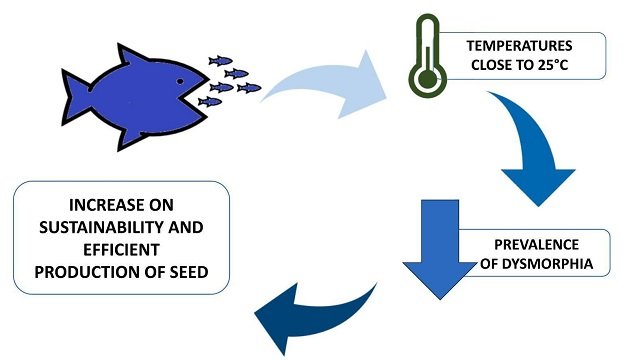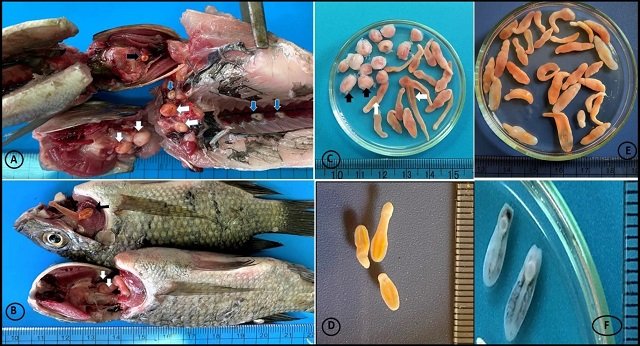
A condition known as urogenital papilla dysmorphia (UPD) can significantly hinder the reproductive performance of Nile tilapia.
The scientific journal Aquaculture published an article, developed by scientists from the Federal University of Minas Gerais, which provides insights into the factors influencing the prevalence of UPD and its impact on reproductive success.
The Devastating Impact of UPD
UPD refers to an abnormality in the urogenital papilla, a vital structure involved in reproduction. This study confirms that urogenital papilla dysmorphia, particularly in severe cases, drastically reduces the number of eggs a female tilapia can produce.
Understanding the Causes of UPD
Previous research has implicated temperature as a potential factor contributing to UPD in Nile tilapia. However, the specific genetic and environmental factors influencing its development remain unclear. To address this knowledge gap, the researchers conducted a comprehensive study to investigate the etiopathogenesis of urogenital papilla dysmorphia in two distinct populations of Nile tilapia.
Genetics vs. Environment: Uncovering the Culprits
Two groups of Nile tilapia, a base generation and a generation selected for body weight, were exposed to different temperature regimes during early development. The fish were then monitored to determine UPD prevalence, reproductive performance, and hormonal changes. Bacteriological analyses were also performed to rule out bacterial infections.
The scientists studied the combined effects of genetics and environmental factors, specifically temperature and bacterial agents, on the prevalence of urogenital papilla dysmorphia. Interestingly, no bacterial influence was found. However, temperature during the first crucial 60 days after yolk sac absorption (daysa) emerged as a critical factor.
The Importance of Temperature Control
The study revealed a clear correlation between warmer rearing temperatures and a dramatic increase in UPD prevalence. Notably, fish reared at a moderate temperature (27-30 °C) during this early period exhibited similar rates of urogenital papilla dysmorphia regardless of their genetic origin (selected for fast growth or not). In contrast, those raised at high temperatures (30-33 °C) showed a significant increase in UPD, even if they were genetically predisposed to faster growth.
Hormonal Disruption: A Possible Explanation
The research suggests a potential link between urogenital papilla dysmorphia and hormonal imbalances. Fish exposed to higher temperatures exhibited altered levels of key reproductive hormones (estradiol and 11-ketotestosterone), which could contribute to the development of UPD.
Stay Always Informed
Join our communities to instantly receive the most important news, reports, and analysis from the aquaculture industry.
Recommendations for Optimal Rearing
Based on these findings, the study recommends raising Nile tilapia breeders (broodstock) at temperatures around 25 °C during the first 60 days. This approach can significantly reduce the prevalence of UPD, resulting in healthier and more productive fish.
Conclusion
“Our results suggest that both genetic factors and temperature play important roles in the etiopathogenesis of urogenital papilla dysmorphia, while an infectious cause seems unlikely. The increase in UPD prevalence results in a decrease in reproductive performance,” the researchers conclude.
This research provides valuable information for tilapia producers. By implementing temperature control measures during the early growth stages, they can minimize the occurrence of urogenital papilla dysmorphia and optimize breeding success. Further studies are needed to fully understand the complex interactions between genetics, environment, and the development of UPD.
The study was funded by FAPEMIG (Research Support Foundation of the State of Minas Gerais), CAPES (Coordination for the Improvement of Higher Education Personnel), and CNPq (National Council for Scientific and Technological Development).
Contact
Érika Ramos de Alvarenga
Laboratório de Aquacultura (LAQUA), Escola de Veterinária, Universidade Federal de Minas Gerais
Av. Antônio Carlos, n° 6627, Caixa Postal 567, Campus da UFMG, CEP 30123-970, Belo Horizonte, MG, Brazil.
Email: erika.ralvarenga@gmail.com
Reference
Bezerra, V. M., Reis, G. P. A., De Melo, C. L., Menezes, W. F., Dos Santos, B. D., Ferreira, M. P., Pires, D. C., Da Costa, F. F. B., Ramírez, J. F. P., Teixeira, J. P., Leal, C. A. G., Ribeiro, Y. M., Turra, E. M., Teixeira, E. D. A., & Alvarenga, É. R. D. (2025). A long-term high temperature on young Nile tilapia females affects its urogenital papilla morphology and future reproductive performance. Aquaculture, 595, 741666. https://doi.org/10.1016/j.aquaculture.2024.741666
Editor at the digital magazine AquaHoy. He holds a degree in Aquaculture Biology from the National University of Santa (UNS) and a Master’s degree in Science and Innovation Management from the Polytechnic University of Valencia, with postgraduate diplomas in Business Innovation and Innovation Management. He possesses extensive experience in the aquaculture and fisheries sector, having led the Fisheries Innovation Unit of the National Program for Innovation in Fisheries and Aquaculture (PNIPA). He has served as a senior consultant in technology watch, an innovation project formulator and advisor, and a lecturer at UNS. He is a member of the Peruvian College of Biologists and was recognized by the World Aquaculture Society (WAS) in 2016 for his contribution to aquaculture.




